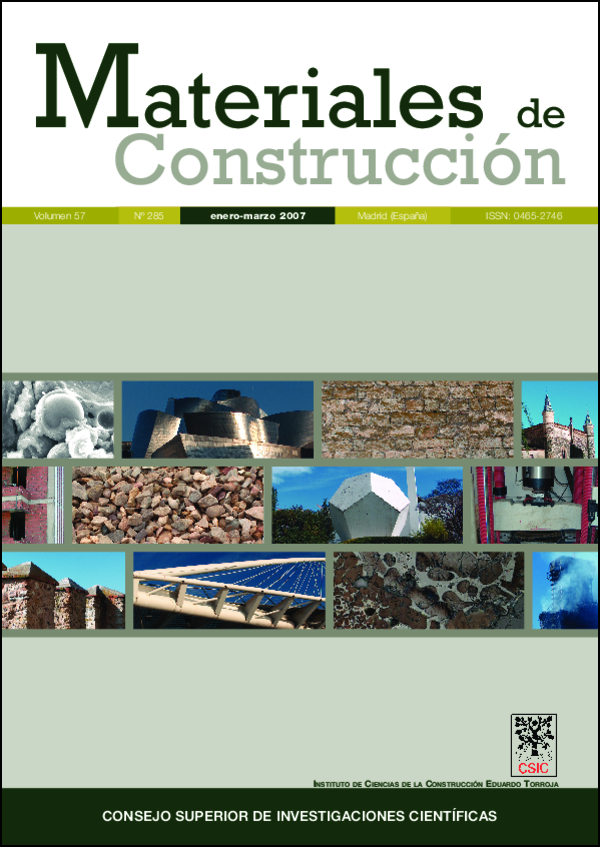Ternary blend cements concrete. Part II: Transport mechanism
DOI:
https://doi.org/10.3989/mc.2007.v57.i285.37Keywords:
blend cements, limestone, granulated blast furnace slag, water absorption, sorptivityAbstract
With today’s extensive use of cements containing two or more additions (blended cements), predicting concrete durability on the grounds of its strength alone leads to errors that may affect the service life of the resulting structures. Indeed, concrete of a given strength class can be made from different materials and proportions of widely varying durability. The present study evaluated water absorption, sorptivity and initial surface absorption in concrete made with unadditioned Portland, binary (limestone) and ternary (limestone and granulated slag) blend cement.
Downloads
References
(1) Gopalan, M. K.: “Sorptivity of fly ash concretes”, Cement and Concrete Research, vol. 26, 8 (1996), pp. 1189-1197. doi:10.1016/0008-8846(96)00105-6
(2) Camarini, G.; Balayssac, J. P. y Detriché, Ch. H.: “Influence of cement type and curing conditions on initial absorption of concrete”, Proc. 2º CANMET/ACI, ACI SP-186, Gramado, Brazil (1999), pp. 427-431.
(3) Menéndez, G.; Bonavetti, V. L. e Irassar, E. F.: “Hormigones con cementos compuestos ternarios. Parte I: Estado fresco y propiedades mecánicas”, Materiales de Construcción, vol. 56, nº 284 (2006), pp. 56-57.
(4) Martys, N. S. y Ferraris, C.F.: “Capillary transport in mortars and concrete”, Cement and Concrete Research, vol. 27, 5 (1997), pp. 747-760.
(5) Menéndez, G.; Bonavetti, V. L. e Irassar, E. F.: “Tasa de Absorción en Hormigones con Cemento Compuesto”, Hormigón, 38 (2002), pp. 25-34.
(6) Montgomery, D. C.: “Diseño y análisis de experimentos”. Grupo Editorial Iberoamérica, México, 1998.
(7) Dhir, R. K. y Mc Carthy, M. J.: “Concrete cover: Role in achievement of in service durability”, 1° Congreso Internacional de Tecnología del Hormigón, AATH. (1998) Buenos Aires, Argentina.
(8) Ho, D. W. S.; Hinczak, I.; Conroy, J. J. y Lewis, R. K.: “Influence of slag cement on the water sorptivity of concrete”, Proc. Fly ash, silica fume, slag and natural puzzolans in Concrete. ACI SP 91-72, Madrid, España, 1986, pp. 1463-1473.
(9) Menéndez, G.; Bonavetti, V. L. e Irassar, E. F.: “Strength development of ternary blended cement with limestone filler and blast-furnace slag”, Cement and Concrete Composites, vol. 25, 1 (2003), pp. 57-63.
(10) Carrasco, M. F.; Menéndez, G.; Bonavetti, V. L. e Irassar, E. F.: “Strength Optimization of “Tailor Made Cement” with Limestone Filler and Blast Furnace Slag”, Cement and Concrete Research, vol. 35, 7 (2005), pp. 1324-1331. doi:10.1016/j.cemconres.2004.09.023
(11) Zhang, C.; Wang, A.; Tang, M. y Liu, X.: “The filling role of pozzolanic material”, Cement and Concrete Research, vol. 26, 6 (1996), pp. 943-947. doi:10.1016/0008-8846(96)00064-6
(12) Sersale, K.: “Advances in Portland and Blended Cement”, Proc. 9th International Congress of the Chemistry of Cement, New Delhi, India, vol. I (1992), pp. 277-279.
(13) Powers, T. C.; Copeland, L. E. y Mann, H. M.: “Capillary continuity or discontinuity in cement paste”, Journal Portland Cement Assoc. Res. Devel. Labs, mayo (1959), pp. 38-48.
(14) Hornain, H.; Marchand, J.; Duhot, V. y Regourd, M.: “Diffusion of chloride ions in limestone filler blended cement pastes and mortars”, Cement and Concrete Research, vol. 8, 25 (1995), pp. 1667-1678. doi:10.1016/0008-8846(95)00163-8
(15) ACI 233. “Ground Granulated Blast-Furnace Slag as a Cementitious Constituent in Concrete”, ACI Manual of Concrete Practice. Part 1. Materials and General Properties of Concrete, 1998.
(16) Bonavetti, V.L.; Donza, H.; Rahhal, V. e Irassar, E. F.: “Influence of initial curing on properties of concrete containing limestone blended cement”, Cement and Concrete Research, 30 (2000), pp. 703-708. doi:10.1016/S0008-8846(00)00217-9
(17) Mohammed, T.; Yamaji, T. y Hamada, H.: “Chloride diffusion, microstructure, and mineralogy of concrete after 15 years of exposure in tidal environment”, ACI Materials Journal, vol. 99, 3 (2002), pp. 256-263.
(18) Alexander, M. G. y Magee, B. J.: “Durability performance of concrete containing condensed silica fume”, Cement and Concrete Research, vol. 29, 6 (1999), pp. 917-922. doi:10.1016/S0008-8846(99)00064-2
(19) Bonavetti, V. L.; Irassar, E. F.; Menéndez, G.; Carrasco, M. F. y Donza, H.: “Durabilidad de hormigones elaborados con cementos binarios y ternarios. El Hormigón Estructural y el Transcurso del Tiempo”, Simposio FIB, La plata Argentina, vol. 1 (2005), pp. 201-208.
(20) Ramezanianpour, A. A. y Malhotra, V. M.: “Effect of curing on the compressive strength, resistance to chloride-ion penetration and porosity of concretes incorporating slag, fly ash or silica fume”, Cement and Concrete Composite, vol. 17, 2 (1995), pp. 125-133. doi:10.1016/0958-9465(95)00005-W
Downloads
Published
How to Cite
Issue
Section
License
Copyright (c) 2007 Consejo Superior de Investigaciones Científicas (CSIC)

This work is licensed under a Creative Commons Attribution 4.0 International License.
© CSIC. Manuscripts published in both the print and online versions of this journal are the property of the Consejo Superior de Investigaciones Científicas, and quoting this source is a requirement for any partial or full reproduction.
All contents of this electronic edition, except where otherwise noted, are distributed under a Creative Commons Attribution 4.0 International (CC BY 4.0) licence. You may read the basic information and the legal text of the licence. The indication of the CC BY 4.0 licence must be expressly stated in this way when necessary.
Self-archiving in repositories, personal webpages or similar, of any version other than the final version of the work produced by the publisher, is not allowed.
















